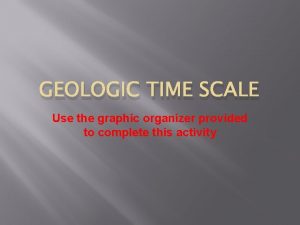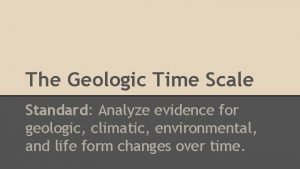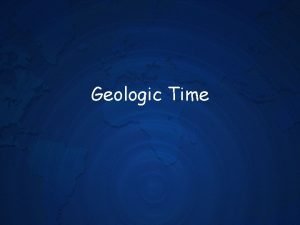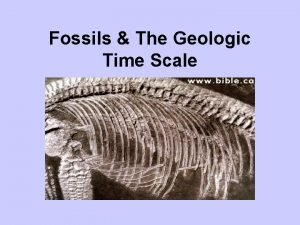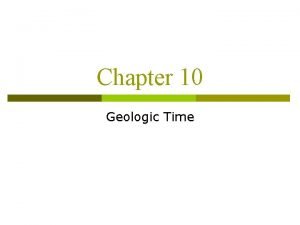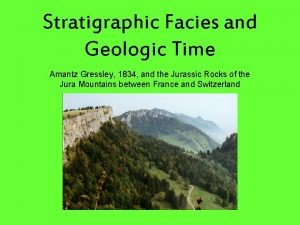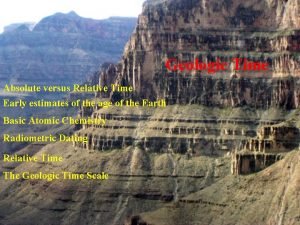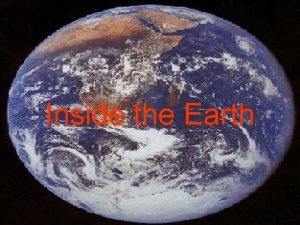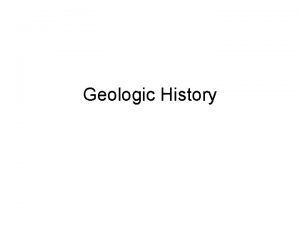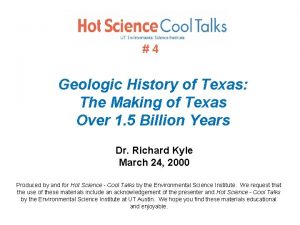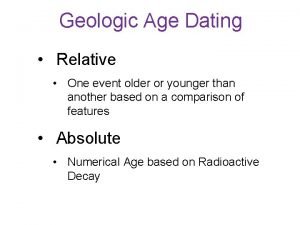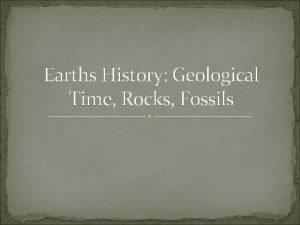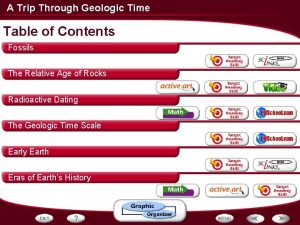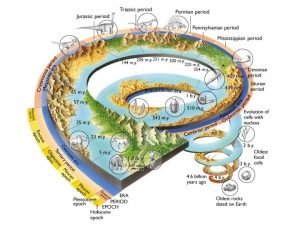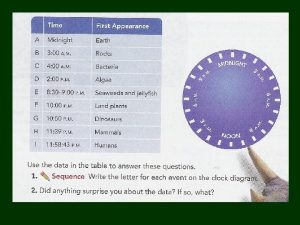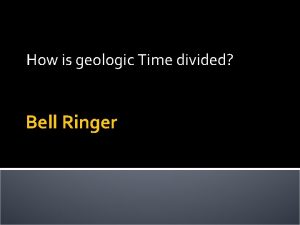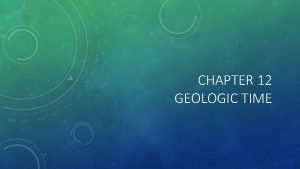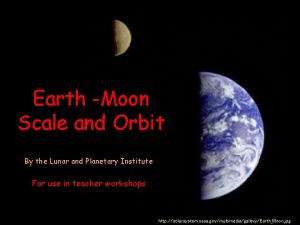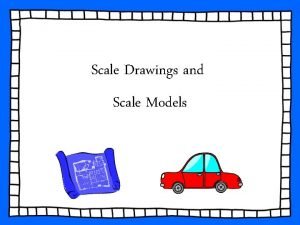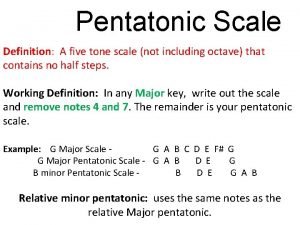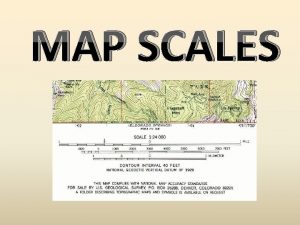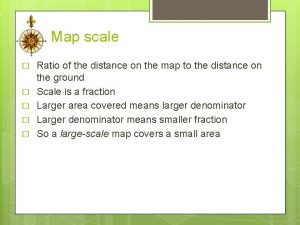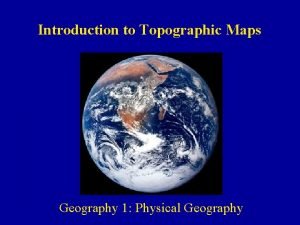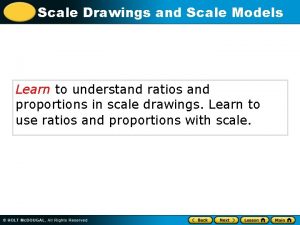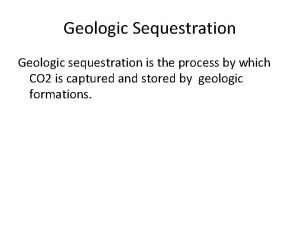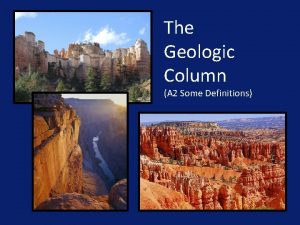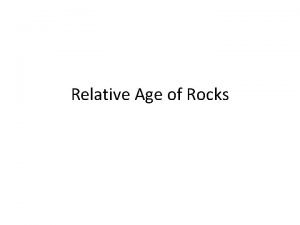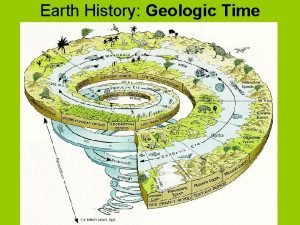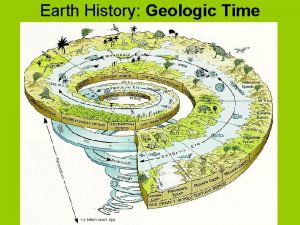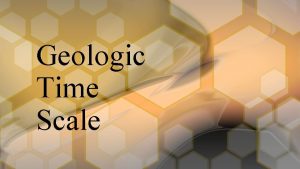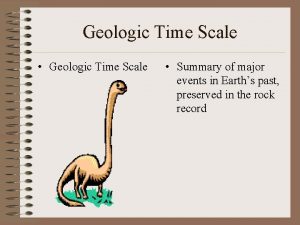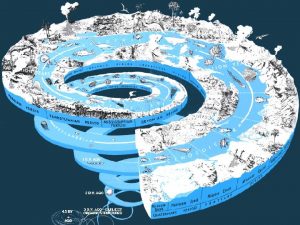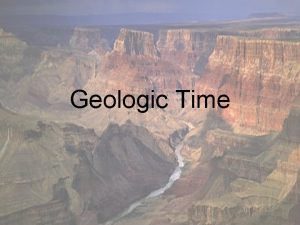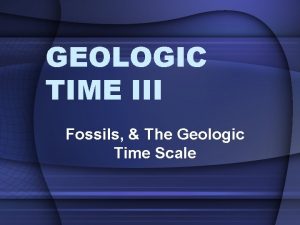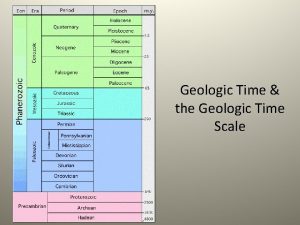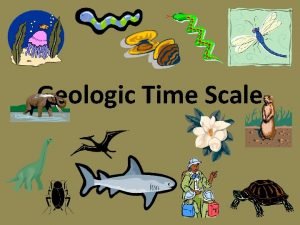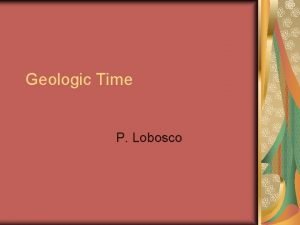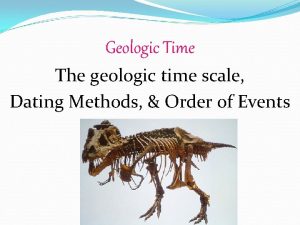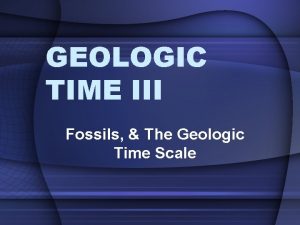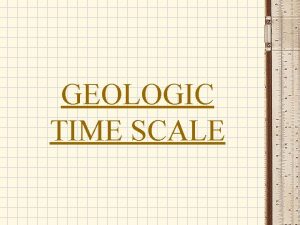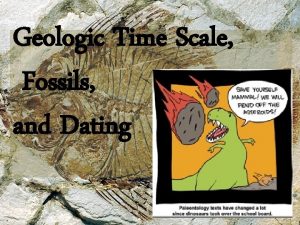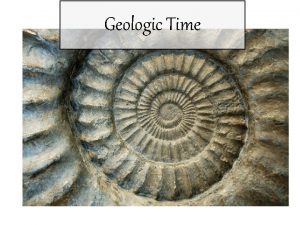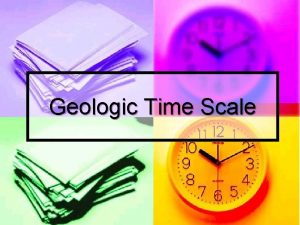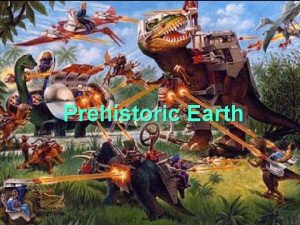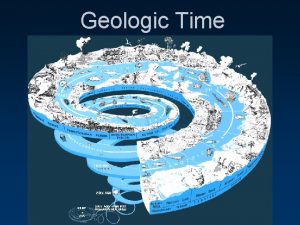Earth History THE GEOLOGIC TIME SCALE Geologic Time





















































- Slides: 53

Earth History THE GEOLOGIC TIME SCALE

Geologic Time Scale The geologic time scale divides Earth’s history into sections defined by major changes on Earth.

Geologic Time Scale The divisions of geologic time scale have no set length. Some eons, eras, periods, and epochs are longer than others.

Geologic Time Scale Eon Era Period Epoch Epoch

Geologic Time Scale The first 4 billion years of Earth’s history is called Precambrian Time (4. 6 BYA-544 MYA)

Precambrian Time Notable events of Precambrian Time:

Precambrian Time Earth formed (4. 6 BYA)

Precambrian Time First fossilized organisms. Stromatolites (3. 5 BYA)

Precambrian Time Earth’s early atmosphere had very little Oxygen.

Precambrian Time Early bacteria did photosynthesis, which releases Oxygen. This went on for millions of years, filling Earth’s atmosphere with Oxygen.

Precambrian Time Natural selection led to animals that used and required Oxygen to survive.

Precambrian Time Mass Extinction (544 MYA) Caused by geologic and climate changes.

Mass Extinctions All the major divisions of the geologic time scale are due to mass extinctions. Mass extinction-the dying off of many species at one time.

Mass Extinctions 99% of all species that ever lived are extinct! Mass extinctions can be caused by: climate change, volcanic eruptions, asteroid impacts, etc.

Paleozoic Era (544 -245 MYA) First animals with hard parts (shells) 544 MYA

Paleozoic Era Cambrian explosionrapid expansion and evolution of animals with shells.

Paleozoic Era First fish (500 MYA)

Paleozoic Era First land plants (470 MYA)

Paleozoic Era First insects (400 MYA)

Paleozoic Era First trees (385 MYA)

Paleozoic Era First amphibians (370 MYA)

Paleozoic Era First amniotes (egg laying animals): 360 MYA

Paleozoic Era The first amniotes would become the ancestors of all dinosaurs, reptiles, and modern mammals (including us!)

Paleozoic Era The Carboniferous period had huge insects like 10 cm cockroaches and 74 cm dragonflies!

Paleozoic Era Pangaea formed (270 MYA)

Paleozoic Era Permian-Triassic Mass Extinction (245 MYA) 90% of everything on Earth was wiped out.

Paleozoic Era The Permian. Triassic extinction is the largest mass extinction in Earth’s historycalled “the Great Dying. ”

Mesozoic Era (245 -66 MYA) First dinosaurs (230 MYA).

Mesozoic Era First mammals (220 MYA).

Mesozoic Era Pangaea breaks apart (200 MYA)

Mesozoic Era Triassic-Jurassic Extinction (200 MYA) Likely due to climate change, rising sea levels, and an increase in atmospheric CO 2

Mesozoic Era After the Triassic. Jurassic extinction, dinosaurs dominated the Mesozoic.

Dinosaurs Stegosaurus (164 -145 MYA)

Dinosaurs Tyrannosaurus Rex (70 -66 MYA)

Dinosaurs There was more time between the Stegosaurus and the TRex than between the TRex and you!

Mesozoic Era Modern day birds are the living descendants of dinosaurs.

Mesozoic Era Archaeopteryx is an important fossil from the Jurassic period linking birds and dinosaurs. It is a dinosaur-like skeleton with fossilized feathers.

Mesozoic Era First Birds (150 MYA)

Mesozoic Era First flowering plants (140 MYA)

Mesozoic Era Near the end of the Mesozoic Era, mammals increased in numbers as dinosaurs began to go extinct.

Mesozoic Era K-T Mass Extinction (66 MYA) An asteroid impact was a major reason for this extinction. Volcanic eruptions may have also played a role.

Mesozoic Era 85% of all living things were wiped out, including the remaining dinosaurs. Luckily for us, many mammals survived.

Cenozoic Era (66 MYA-Present) The Cenozoic Era is known as “the age of mammals. ”

Cenozoic Era The descendants of the organisms that survived the Cretaceous extinction (66 MYA) are the organisms that we know today.

Cenozoic Era Some mammals evolved BACK into the ocean during the Cenozoic to become modern marine mammals like whales and dolphins.

Cenozoic Era First Horses (60 MYA)

Cenozoic Era First Primates (55 MYA) Primate- forward facing eyes, hands and feet, and opposable thumbs

Cenozoic Era Early Hominins (primitive humans) 3. 5 MYA

Cenozoic Era Most recent ice age began (2 MYA)

Cenozoic Era Homo erectus (upright man) 1. 6 MYA

Cenozoic Era Homo erectus went extinct 143, 000 years ago

Cenozoic Era Homo sapiens (Us!) ~200, 000 years ago

Cenozoic Era We are the first and only species of hominin to not share the planet with other hominin species.
 Compare geologic time with the geologic column.
Compare geologic time with the geologic column. Geologic time graphic organizer
Geologic time graphic organizer How is the geologic time scale organized
How is the geologic time scale organized How is the geologic time scale organized
How is the geologic time scale organized Geologic time scale animals
Geologic time scale animals The longest subdivision of the geologic time scale is the
The longest subdivision of the geologic time scale is the Geologic time scale drawing
Geologic time scale drawing Geologic time
Geologic time Geologic time scale
Geologic time scale Silurian period
Silurian period Geologic
Geologic Geologic time scale drawing
Geologic time scale drawing Geologic layers of earth
Geologic layers of earth Definition of geologic history
Definition of geologic history Geologic history of texas
Geologic history of texas Principle of original horizontality
Principle of original horizontality Disconformity
Disconformity Fossils
Fossils A trip through geologic time answer key
A trip through geologic time answer key Eon division
Eon division Time scale
Time scale What is the longest subdivision in geologic time
What is the longest subdivision in geologic time Chapter 12 geologic time
Chapter 12 geologic time Earth moon to scale
Earth moon to scale Line scale geography
Line scale geography What is the scale of a drawing
What is the scale of a drawing Pentatonic is a tone scale
Pentatonic is a tone scale What is a map scale
What is a map scale Ratio map scale
Ratio map scale Large scale vs small scale map
Large scale vs small scale map Large scale vs small scale map
Large scale vs small scale map Scale out vs scale up
Scale out vs scale up Scale up and scale out in hadoop
Scale up and scale out in hadoop Scale drawings/models & scale factor
Scale drawings/models & scale factor Engineering108
Engineering108 What is a proportional two dimensional drawing of an object
What is a proportional two dimensional drawing of an object Pasero opioid sedation scale
Pasero opioid sedation scale Scale up scale down
Scale up scale down Protractor inner and outer scale
Protractor inner and outer scale Inner and outer scale of protractor
Inner and outer scale of protractor Adjustable cross staff in surveying
Adjustable cross staff in surveying Geologic sequestration
Geologic sequestration Geologic column definition
Geologic column definition Relative age
Relative age Cal gem
Cal gem Hát kết hợp bộ gõ cơ thể
Hát kết hợp bộ gõ cơ thể Slidetodoc
Slidetodoc Bổ thể
Bổ thể Tỉ lệ cơ thể trẻ em
Tỉ lệ cơ thể trẻ em Voi kéo gỗ như thế nào
Voi kéo gỗ như thế nào Chụp tư thế worms-breton
Chụp tư thế worms-breton Chúa yêu trần thế
Chúa yêu trần thế Các môn thể thao bắt đầu bằng từ đua
Các môn thể thao bắt đầu bằng từ đua Thế nào là hệ số cao nhất
Thế nào là hệ số cao nhất

